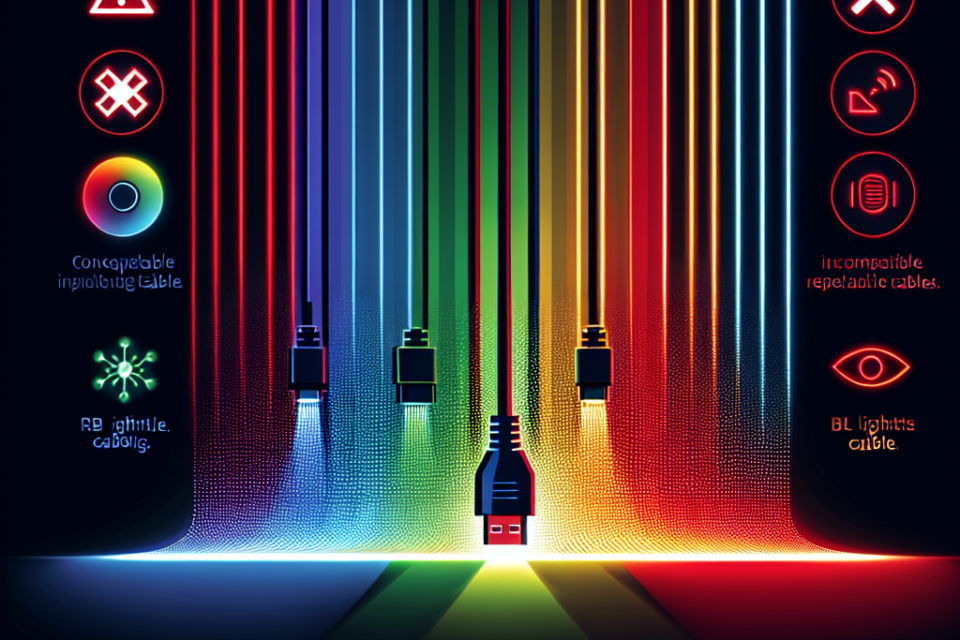Why RGB Lighting Doesn’t Work with Certain Cable Types

RGB lighting has become a popular trend in the realm of electronics, especially in gaming and custom PC builds. However, users sometimes face issues where their RGB lighting just won’t work, particularly when using certain types of cables. Understanding the reasons behind this can save you time and frustration. In this article, we will explore the implications of using incompatible cables for RGB lighting setups and how to ensure your system operates smoothly.
| Aspect | Detail |
|---|---|
| Signal Type | Analog vs Digital |
| Connector Type | 3-pin vs 4-pin |
| Cable Material | Quality of materials used |
| Length of Cable | Impact of distance on signal strength |
| Power Supply | Sufficient power delivery for RGB devices |
1. Understanding RGB Lighting
RGB lighting works by combining red, green, and blue colors in various intensities to produce a range of colors. It is commonly used in computer hardware, peripherals, and ambient lighting. However, the effectiveness of RGB lights heavily depends on the components and cables used in the setup.
2. Types of RGB Connectors
2.1 3-pin vs 4-pin Connectors
The two most common types of RGB connectors are the 3-pin and 4-pin connectors. The key difference lies in the number of pins:
- 3-pin RGB: This configuration is usually used for addressable RGB lighting, allowing for individual control of each LED light within the strip.
- 4-pin RGB: This configuration is commonly used for standard RGB setups where colors are synchronized across the entire strip.
2.2 Compatibility Issues
Using a 4-pin cable for a 3-pin RGB setup (or vice versa) can lead to compatibility issues that might prevent the lighting from functioning correctly. It’s essential to ensure that the connector type matches the RGB header on the motherboard or controller.
3. Signal Integrity and Cable Quality
The quality of the cables used in an RGB setup can significantly impact signal integrity. Poorly made cables can cause signal degradation, leading to flickering or non-responsive lighting. High-quality cables are often shielded and use better materials that help maintain a strong signal throughout the distance.
3.1 Length of the Cable
Another factor that affects RGB lighting performance is the length of the cable. As the distance increases, the signal can weaken, leading to performance issues. Generally, it’s recommended to keep RGB cables as short as possible while still meeting your needs.
4. The Role of Power Supply
The power supply is another critical aspect that can affect RGB lighting operation. Insufficient wattage can cause RGB components to underperform or fail to light up altogether. Ensure that you are using a Power Supply Unit (PSU) that can adequately support the overall power requirements of your RGB components.
4.1 Testing Power Output
Before connecting your RGB components, it might be beneficial to test the power output to ensure that everything is functioning correctly. Use a multimeter to check the voltage levels if needed.
5. Troubleshooting RGB Issues
If you are facing issues with your RGB lighting, here are some steps you can take to troubleshoot:
- Check compatibility between connectors and RGB headers.
- Inspect the quality of your cables and replace them if necessary.
- Ensure that your power supply has adequate wattage.
- Minimize cable length to prevent signal degradation.
- Connect RGB components securely to prevent connection issues.
6. Recommended RGB Setup Practices
To achieve optimal performance for your RGB lighting, consider following these best practices:
- Always match the connector type to the RGB header specifications.
- Invest in high-quality cables that are suitable for RGB applications.
- Keep cable lengths manageable and consider using PWM devices to extend range safely.
- Ensure that your power supply is rated efficiently to handle all necessary components.
7. Conclusion
RGB lighting can enhance the aesthetic appeal of any gaming setup or home office, but utilizing the correct cables is key to ensuring that everything operates as intended. By considering factors such as connector type, cable quality, signal integrity, and power supply, you can avoid the common pitfalls associated with RGB lighting failures. Remember that when in doubt, consult the manufacturer’s guidelines or community resources for assistance in creating your optimal RGB experience.
